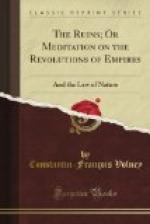“Ye priests! who murmur at this relation, you wear his emblems all over your bodies; your tonsure is the disk of the sun; your stole is his zodiac;* your rosaries are symbols of the stars and planets. Ye pontiffs and prelates! your mitre, your crozier, your mantle are those of Osiris; and that cross whose mystery you extol without comprehending it, is the cross of Serapis, traced by the hands of Egyptian priests on the plan of the figurative world; which, passing through the equinoxes and the tropics, became the emblem of the future life and of the resurrection, because it touched the gates of ivory and of horn, through which the soul passed to heaven.”
* “The Arabs,” says Herodotus, “shave their heads in a circle and about the temples, in imitation of Bacchus (that is the sun), who shaves himself is this manner.” Jeremiah speaks also of this custom. The tuft of hair which the Mahometans preserve, is taken also from the sun, who was painted by the Egyptians at the winter solstice, as having but a single hair upon his head. . . .
The robes of the goddess
of Syria and of Diana of Ephesus,
from whence are borrowed
the dress of the priests; have the
twelve animals of the
zodiac painted on them. . . .
Rosaries are found upon
all the Indian idols, constructed
more than four thousand
years ago, and their use in the East
has been universal from
time immemorial. . . .
The crozier is precisely
the staff of Bootes or Osiris.
(See plate.)
All the Lamas wear the
mitre or cap in the shape of a cone,
which was an emblem
of the sun.




